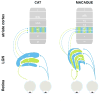Binocular response modulation in the lateral geniculate nucleus
- PMID: 29473163
- PMCID: PMC6107447
- DOI: 10.1002/cne.24417
Binocular response modulation in the lateral geniculate nucleus
Abstract
The dorsal lateral geniculate nucleus of the thalamus (LGN) receives the main outputs of both eyes and relays those signals to the visual cortex. Each retina projects to separate layers of the LGN so that each LGN neuron is innervated by a single eye. In line with this anatomical separation, visual responses of almost all of LGN neurons are driven by one eye only. Nonetheless, many LGN neurons are sensitive to what is shown to the other eye as their visual responses differ when both eyes are stimulated compared to when the driving eye is stimulated in isolation. This, predominantly suppressive, binocular modulation of LGN responses might suggest that the LGN is the first location in the primary visual pathway where the outputs from the two eyes interact. Indeed, the LGN features several anatomical structures that would allow for LGN neurons responding to one eye to modulate neurons that respond to the other eye. However, it is also possible that binocular response modulation in the LGN arises indirectly as the LGN also receives input from binocular visual structures. Here we review the extant literature on the effects of binocular stimulation on LGN spiking responses, highlighting findings from cats and primates, and evaluate the neural circuits that might mediate binocular response modulation in the LGN.
Keywords: binocular combination; binocular integration; binocular vision; lateral geniculate nucleus; neurophysiology.
© 2018 Wiley Periodicals, Inc.
Figures



References
-
- Ahlsén G, Lindström S. Corticofugal projection to perigeniculate neurones in the cat. Acta Physiologica Scandinavica. 1983;118(2):181–184. - PubMed
-
- Ahlsén G, Lindström S, Sybirska E. Subcortical axon collaterals of principal cells in the lateral geniculate body of the cat. Brain Research. 1978;156(1):106–109. - PubMed
-
- Alais D, Blake R. Binocular Rivalry. MIT Press; 2005.
-
- Andrews TJ, Blakemore C. Integration of motion information during binocular rivalry. Vision Research. 2002;42(3):301–309. - PubMed
Publication types
MeSH terms
Grants and funding
LinkOut - more resources
Full Text Sources
Other Literature Sources
Miscellaneous

